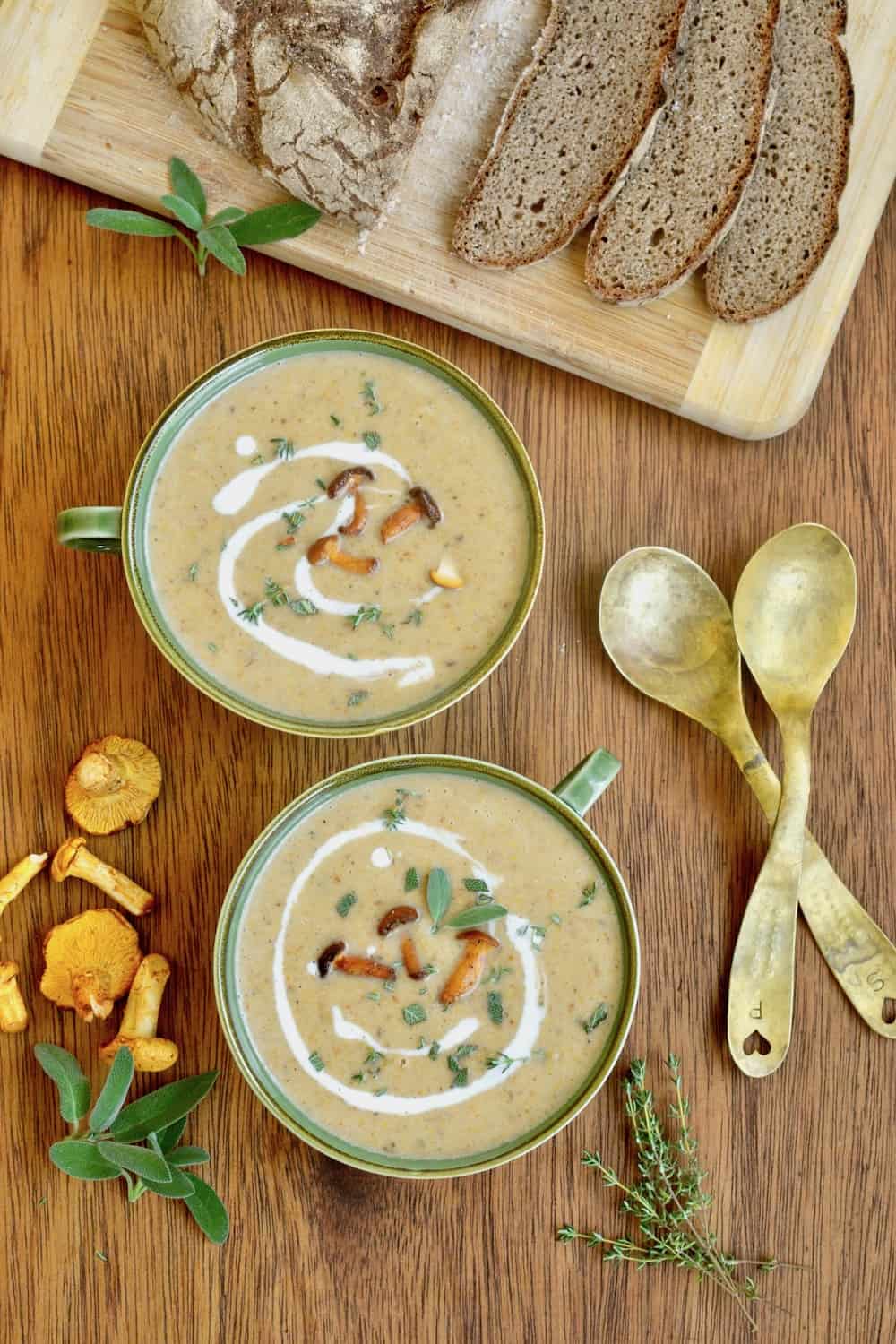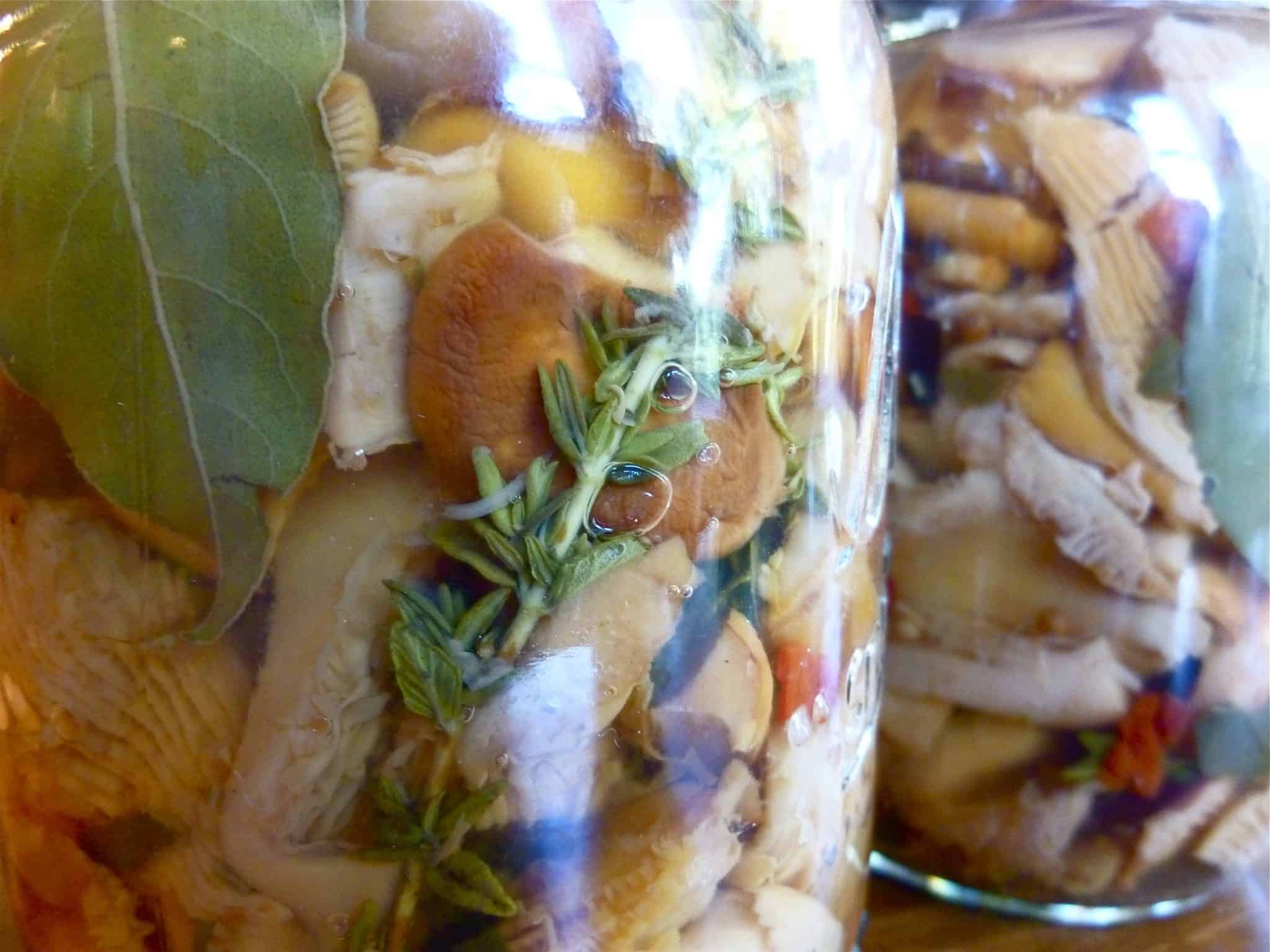
Here are some great chanterelle mushroom recipes to make the most out of your fresh, dried or frozen chanterelles.


Global Food Recipes
with Spices and Herbs
Free E-Book available for a limited time. Grab yours now and get instantly inspired!
You missed out!
Jump to:
- 📕 What are Chanterelle Mushrooms?
- 📜 Chanterelle Mushroom Recipes
- Sauteed Chanterelle Mushroom Recipe
- Creamy Chanterelle Soup Recipe
- Classic Jägerschnitzel Recipe
- Vegetarian Summer Wild Mushroom Paella with Chanterelles Recipe
- Chanterelle Ravioli with Sage and Rosemary Oil Recipe
- Hearty Farmer’s Sausage Sweet Corn Chowder Recipe
- Home Canned Chanterelle Mushrooms Recipe
- Chanterelle Herb Biscuits with Pine Nuts Recipe
- Sweet Pickled Chanterelles Recipe
- Vegan Mushroom Carnitas Recipe
- Tagliolini Pasta with Chanterelle Mushrooms and Speck Recipe
- Chanterelle Tart with Ricotta, Rosemary and a Phyllo Crust Recipe
- 💡 Tips
- 📖 Recipe
- Dried Chanterelle Mushrooms
- 💬 Comments
📕 What are Chanterelle Mushrooms?
Chanterelle mushrooms, or chanterelles as they are also called, are vibrant yellow or golden colored and funnel-shaped mushrooms.
Variations exist between the white and black color spectrum. Some chanterelles have almost no gills and others have deep gils.
The cap is smooth and wavy and looks a bit like a trumpet. The stem is one piece, not hollow but rather fleshy. Chanterelle mushrooms taste fruity and a bit peppery.
They are called Pfifferlinge in German or Eierschwammerl (egg mushroom) or Reherl in Austrian dialects, girolle in French and rebozuelo in Spanish.
They grow mainly in the wild in the Northern Hemisphere when the weather cools down.
Foragers like to collect chanterelles because they are easily recognized in forests. They grow on mossy mixed tree forests (leaf and need trees) and they grow quickly within days when the temperatures are below 70 Fahrenheit (20 °C).
The perfect foraging time to find chanterelles is from later summer to late October.
Most mushrooms are cultivated on logs but not chanterelle mushrooms. In fact, commercial chanterelles in Europe are mostly foraged in East Europe and are not cultivated.
Yet, there are ways to grow chanterelles from spores in a controlled environment.
📜 Chanterelle Mushroom Recipes
Here are some great uses for your chanterelle. Most turn out best with fresh mushrooms, but you can also use frozen chanterelles.
Sauteed Chanterelle Mushroom Recipe
Creamy Chanterelle Soup Recipe
Classic Jägerschnitzel Recipe
Vegetarian Summer Wild Mushroom Paella with Chanterelles Recipe
Chanterelle Ravioli with Sage and Rosemary Oil Recipe
Hearty Farmer’s Sausage Sweet Corn Chowder Recipe
Home Canned Chanterelle Mushrooms Recipe
Chanterelle Herb Biscuits with Pine Nuts Recipe
Sweet Pickled Chanterelles Recipe
Vegan Mushroom Carnitas Recipe
Tagliolini Pasta with Chanterelle Mushrooms and Speck Recipe
Chanterelle Tart with Ricotta, Rosemary and a Phyllo Crust Recipe
💡 Tips
- Clean chanterelle mushrooms from dirt by using a mushroom brush.
- Chanterelles are never rinsed or taken through water because water gets trapped in the gils. It also reduces the quality of your mushrooms instantly.
- To bring out the flavors of these mushrooms, you just need to season them with salt and pepper. Garlic and onion make for a lovely addition.
- Chanterelle are also great with fresh or dried herbs such as thyme, rosemary, and savory herb
- They are done cooking within minutes. Olive oil is often a preferred oil to cook chanterelles.
- Chanterelles pair well with diary-based products such as butter and cream in a sauce.
- Explore layers of flavors by deglazing sautéed mushrooms with white wine
- Chanterelle pair well with other mushrooms too, such as in a mixed mushroom risotto with oyster mushrooms, button mushrooms and porcini.

Global Food Recipes
with Spices and Herbs
Free E-Book available for a limited time. Grab yours now and get instantly inspired!
You missed out!

📖 Recipe

Dried Chanterelle Mushrooms
Instructions
- Brush off any mud or impurities with a mushroom brush from your chanterelle mushrooms to clean them. *see Notes about rinsing/water1 Pound Chanterelle Mushrooms
- Optional: Slice, half or quarter mushrooms.
- Keep your dehydrator ready as per instruction. Turn the device on.
- Place and spread the mushrooms on the dehydrator baskets. Don't overcrowd as this can prolong the drying time too but also keep enough mushrooms to dry to use the space properly.
- Keep one basket over the other on the dehydrator. As per device, you may be able to stack up to 10 baskets. The more baskets with mushrooms the longer it can take for the chanterelles to dry in the top baskets.
- Keep the mushrooms to dry at a medium to high temperature (about 135. F./60. C.) or as per device instructions. The drying time is about 10 to 12 hours, depending on the size of your mushrooms. The larger, the longer they will take to dry.
- Check on the drying process of your dried red currants. I like to switch the position of the baskets every few hours so that the chanterelle get equally dried, and I make sure that the mushrooms don't stick to the grid.
- Dry crispy or chewy, the way you want. Store your cooled and dried mushrooms in an airtight container until further use.
Notes
Equipment
- 1 Food Dehydrator with Racks (dry in the sun)













Comments
No Comments